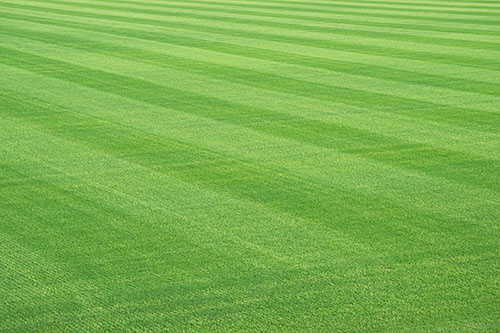The Secret to Mowing Patterns
May 10, 2021

Admit it. You’ve seen the beautiful stripes in your neighbor’s lawn that makes the grass look like a ballpark, and you can’t help but feel a little envious. Luckily, striping your yard is not as hard as you might think.
The biggest secret to creating patterns is understanding how the light reflects off of individual blades of grass. Blades bent towards you appear dark while blades bent away from you appear lighter. Patterns require your grass to be 3 to 3 ½ inches high after you are done mowing so that the blades can achieve a decent bend.
The first step in mowing a pattern that is sure to turn heads is to make sure your grass is healthy and vibrant. We recommend using turf-building lawn food four times a year to strengthen your grass, build deep roots, and increase your grass’s ability to absorb nutrients and water.
Decide on a pattern before you start mowing and change it up each time so that the grass does not become trained to bend too far in one direction. The three most common patterns are striped, checkerboard, and diamond lawn patterns.
Striped Lawn Pattern
The most common pattern is a striped lawn pattern because it is efficient and easy to achieve. Start by mowing around the perimeter of your yard, then find a straight driveway or path to follow. Mow parallel stripes across the rest of your yard, mowing each row in the opposite direction. Give your lawn a polished look by mowing a final strip around the edges of your yard to hide any irregularities.
Checkerboard Lawn Pattern
Another common pattern is the checkerboard lawn pattern, which builds off the striped lawn pattern. Simply mow across the stripes you’ve already completed at right angles to the first. Once again, mow around the perimeter after you are finished to hide any turn marks.
Diamond Lawn Pattern
The diamond lawn pattern could be considered expert-level and will really make your lawn stand out. After finishing your checkerboard lawn pattern, mow from one corner of your yard to the other in diagonal stripes to achieve a diamond pattern.
Visit your local Co-op for all your lawn maintenance needs and for more localized lawn care advice. For more content like this, check out the latest issue of the Cooperator.
The biggest secret to creating patterns is understanding how the light reflects off of individual blades of grass. Blades bent towards you appear dark while blades bent away from you appear lighter. Patterns require your grass to be 3 to 3 ½ inches high after you are done mowing so that the blades can achieve a decent bend.
The first step in mowing a pattern that is sure to turn heads is to make sure your grass is healthy and vibrant. We recommend using turf-building lawn food four times a year to strengthen your grass, build deep roots, and increase your grass’s ability to absorb nutrients and water.
Decide on a pattern before you start mowing and change it up each time so that the grass does not become trained to bend too far in one direction. The three most common patterns are striped, checkerboard, and diamond lawn patterns.
Striped Lawn Pattern
The most common pattern is a striped lawn pattern because it is efficient and easy to achieve. Start by mowing around the perimeter of your yard, then find a straight driveway or path to follow. Mow parallel stripes across the rest of your yard, mowing each row in the opposite direction. Give your lawn a polished look by mowing a final strip around the edges of your yard to hide any irregularities.
Checkerboard Lawn Pattern
Another common pattern is the checkerboard lawn pattern, which builds off the striped lawn pattern. Simply mow across the stripes you’ve already completed at right angles to the first. Once again, mow around the perimeter after you are finished to hide any turn marks.
Diamond Lawn Pattern
The diamond lawn pattern could be considered expert-level and will really make your lawn stand out. After finishing your checkerboard lawn pattern, mow from one corner of your yard to the other in diagonal stripes to achieve a diamond pattern.
Visit your local Co-op for all your lawn maintenance needs and for more localized lawn care advice. For more content like this, check out the latest issue of the Cooperator.